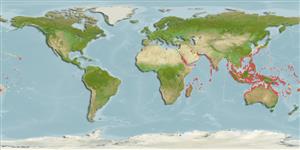Common names from other countries
Classification / Names / Names
ชื่อสามัญ | ชื่อพ้อง | Catalog of Fishes (gen., sp.) | ITIS | CoL | WoRMS
Environment: milieu / climate zone / depth range / distribution range
นิเวศวิทยา
; ระดับความลึก 0 - 46 m (Ref. 75840). Tropical
Indo-Pacific: from East and South Africa, including Madagascar, the Red Sea and the Persian Gulf, to eastern Polynesia; north to Japan and Hawaii, and south to Queensland.
Length at first maturity / ขนาด / น้ำหนัก / Age
Maturity: Lm ? range ? - ? cm Max length : 7.5 cm SHL เพศผู้/กระเทย; (Ref. 348); common length : 5.0 cm SHL เพศผู้/กระเทย; (Ref. 348)
This is the most common Barbatia species of the Indo-Pacific (Ref. 2922). Attached by byssus among rocks, underside of coral slabs, or nestling in crevices. Littoral and sublittoral (Ref. 348). Also occurs in shallow areas of lagoons where it is attached to dead corals (Ref. 65033). Dead shells found on the beaches (Ref. 88739).
Life cycle and mating behavior
วัยเจริญพันธุ์ | การสืบพันธุ์ | การวางไข่ | เซลสืบพันธ์ของเพศเมีย(ไข่) | ความดกของไข่ | ตัวอ่อน
Members of the class Bivalvia are mostly gonochoric, some are protandric hermaphrodites. Life cycle: Embryos develop into free-swimming trocophore larvae, succeeded by the bivalve veliger, resembling a miniature clam.
Poutiers, J.M. 1998. (Ref. 348)
IUCN Red List Status (Ref. 130435)
CITES status (Ref. 108899)
Not Evaluated
Not Evaluated
Threat to humans
Harmless
Human uses
การประมง: การค้า
| FishSource |
เครื่องมือ
ข้อมูลเพิ่มเติม
Age/SizeการเจริญเติบโตLength-weightLength-lengthสัณฐานวิทยาตัวอ่อนอุดมสมบรูณ์
แหล่งที่มาจากอินเตอร์เน็ต
Estimates based on models
Preferred temperature
(Ref.
115969): 24.7 - 29.3, mean 28.5 (based on 3234 cells).
Vulnerability
Low vulnerability (10 of 100).
Price category
Unknown.
